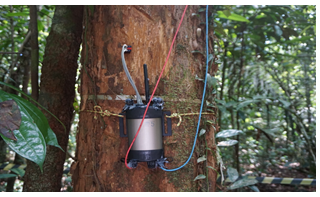A new global database of sap flow measurements for understanding and modeling plant water use.
The Science
Plant transpiration links vegetation physiology with hydrological, energy, and carbon budgets at the land–atmosphere interface. However, despite being the dominant terrestrial evaporative flux at the global scale, transpiration and its response to environmental drivers are currently not well constrained by observations. Here we introduce the first global compilation of whole-plant transpiration data from sap flow measurements (SAPFLUXNET, https://sapfluxnet.creaf.cat/). SAPFLUXNET contains 202 globally distributed datasets with sap flow time series for 2714 plants of 174 species.
The Impact
SAPFLUXNET adds to existing plant trait datasets, ecosystem flux networks, and remote sensing products to help increase our understanding of plant water use, plant responses to drought, and ecohydrological processes. Through provision of this global database, discovery of new controls over vegetation water use can be achieved. This dataset also provides the first global benchmark of transpiration for model evaluation. Ultimately this database will rapidly advance our ability to understand and predict vegetation function and climate and hydrological feedbacks.
Summary
To generate Sapfluxnet, we harmonized and quality-controlled individual datasets supplied by contributors worldwide in a semi-automatic data workflow implemented in the R programming language. Datasets include sub-daily time series of sap flow and hydrometeorological drivers for one or more growing seasons, as well as metadata on the stand characteristics, plant attributes, and technical details of the measurements. SAPFLUXNET has a broad bioclimatic coverage. Accompanying radiation and vapour pressure deficit data are available for most of the datasets, while on-site soil water content is available for 56 % of the datasets. Many datasets contain data for species that make up 90 % or more of the total stand basal area, allowing the estimation of stand transpiration in diverse ecological settings.

A sap flow sensor on a tree in Manaus, Brazil. The sensor quantifies water movement based on thermal transport between two sensors located 10cm apart in the vertical orientation. Measurements of sap flow are converted into whole-tree transpiration rates, providing essential knowledge regarding water use and ultimately growth and survival of tropical trees. (courtesy of unknown)
Contact
Nate McDowell, Pacific Northwest National Laboratory, nate.mcdowell@pnnl.gov
Funding
No funding was acknowledged in this paper due to the large number of coauthors and associated funding sources.
Publications
Poyatos R, V. Granda, V. Flo, M. Adams, B. Adorján, et al. 2021. Global transpiration data from sap flow measurements: the SAPFLUXNET database. Earth System Science Data. 13(6), pp.2607-2649. doi.org/10.5194/essd-13-2607-2021